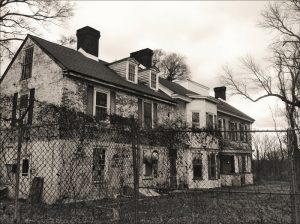Fieldsboro, NJ | View Map

White Hill mansion. The original Georgian style house (ca. 1740), with Flemish bond brick facades, was expanded with a brick addition in the 19th century and later remodeled with shingle-clad bays, projecting additions and dormers, iron cresting, and vernacular Gothic details. The house operated as a well known restaurant from the 1920s until 1982, when the property was purchased by a chemical company. The borough acquired the abandoned house in 2000.
Measuring less than half a square mile in area, Fieldsboro is the smallest municipality in Burlington County. It is bordered by the Delaware River and Bordentown Township, from which it separated in the late nineteenth century. The borough has a population of approximately 600 and is primarily residential.
In early land records, the area was known as White Hill. Like many settlements along this stretch of the Delaware, the location attracted enterprising settlers. Thomas Potts, a tanner and part owner of a nearby iron forge, is thought to be one of the earliest European settlers. Another early settler who prospered here was Robert Field, for whose family the borough is named. By the mid-eighteenth century “White Hill” was a small port with a commercial wharf used by boats sailing between Bordentown and Perth Amboy. At the time of his death in 1774, Robert Field’s considerable holdings included several hundred acres, a bake house, six slaves, a vessel, commercial wharf and large brick manor house which operated as a riverside tavern for many years. It burned in the 1970s. The Fields’ last family residence, now know as White Hill Mansion, is sited on a bluff overlooking the Delaware River. White Hill has links to important people and events of the American Revolution (1775-1783).
After the British army captured Philadelphia in 1777, American frigates and gunboats assigned for defense of the Delaware River were trapped up river and lay at anchor just off Field’s wharf at White Hill. In May 1778, General Washington made a difficult strategic decision and ordered the American fleet burned to prevent the British from capturing it. During the American Revolution many dignitaries, including Hessian commander Count von Donop and his entourage, visited White Hill mansion. In 1779, Robert Field’s widow Mary married Thomas Read, who had commanded the stranded American fleet. Robert Field Jr., the son of Mary and Robert Field, married the daughter of Richard Stockton, a signer of the Declaration of Independence, and poetess Annis Boudinot Stockton. Annis Stockton died at White Hill mansion in 1801. Robert Field experienced financial difficulties and was forced to sell White Hill farm in 1804. The 200-acre farm was purchased by entrepreneur and land developer Jonathan Rhea of Trenton, who mapped out a town and began selling lots. Over the intervening years, White Hill mansion was enlarged and used as a boarding house and restaurant.
When the Camden & Amboy Rail Road, one of the nation’s earliest railroads, arrived here in the 1830s, the settlement became known as White Hill Station. The official name became Fieldsboro when the borough was incorporated in 1850. The C&A located its primary train shop, repair facility and shipping wharf between the village and Black’s Creek. The John Bull and many of the company’s first locomotives were assembled there. After the railroad abandoned the facility in the 1890s, the site was used for pottery making and then metal fabrication. By 1945, the majority of the complex had fallen into disuse. During the mid-twentieth century the riverfront just south of Fieldsboro was home to a ship scrap yard and smelting operation. Their docks were the final resting place for commercial vessels such as tugs, barges, and freighters. Hitler’s 377-foot yacht, the Grille, was brought here and scrapped in 1951.
For more information:
- www.burlingtoncountyhistoricalsociety.org
- www.burlcohistorian.com
- www.wcchc.org/10most.htm
- memory.loc.gov/ammem/collections/habs_haer/index.html
- www.jerseyhistory.org/findingaid.php?aid=1221
Banner credit: The Georgian manor known as the Field-Stevens house was photographed in 1936 by the Historic American Buildings Survey. The house burned in the 1970s. Credit: The Library of Congress, Historic American Buildings Survey. Photograph by Nathaniel R. Ewan.






